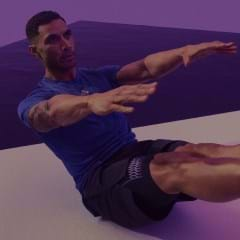Gone are the days of working out purely to get fit, ripped and toned. We’ve cottoned on to the many and varied mental benefits that come from exercise. Now, regular exercise is as much about mood-boosting and mind-strengthening as it is about sweat, calorie burn and muscle fatigue.
Just like we choose workouts based on training stimuli, we can also make training choices based on how workouts may spark neurochemicals and boost brain function. Thankfully, researchers have come to the party providing insights into the exact cognitive benefits driven by different workouts.
A new meta-analysis has considered the data of thousands of participants across 54 randomized controlled trials. Exploring how different exercise impacts cognitive function, researchers found moderate intensity exercise delivered the most significant overall improvement in cognition skills. Resistance training seemed to perform slightly better when it comes to boosting higher-level cognitive skills like reasoning, flexible thinking and self-control. Yoga and tai chi seems to be good at sparking memory boosts, particularly if it is performed at a higher intensity.
In a nutshell:
- The most powerful way to boost cognitive function is with moderate-intensity aerobic exercise.
- Resistance training can improve executive functioning like reasoning and flexible thinking.
- Activities like yoga (and HIIT) have been shown to help boost memory
Interestingly, it seems the older you are, the more likely you are to enjoy the brain-boosting benefits, and women are likely to benefit more from the cognitive benefits of exercise.

Canadian neuroscientist, Dr. Jennifer Heisz is an expert in the neurological power of exercise, saying it helps us deal with stress, ease depression, soothe anxiety, stay sober, alleviate insomnia, keep dementia at bay, as well as making it easier for us to stay focused and be creative. She explains: “One key thing that exercise increases is brain-derived neurotrophic factor (BDNF). This acts as a fertilizer to grow new brain cells and help our existing brain cells function optimally."
“Exercise increases brain-derived neurotrophic factor (BDNF). This acts as a fertilizer to grow new brain cells and help our existing brain cells function optimally." Dr. Jennifer Heisz
The effect can be diverse and powerful, says Heisz, who adds that in some cases the power of exercise can even surpass that of genetics. Research from Heisz’s NeuroFitLab has shown that physical activity levels contribute to dementia risk as significantly as one’s genes. The researchers tracked over 1,600 people, and 25 percent had a genetic risk factor for dementia, which is representative of the population at large. At the start of the study, no one had dementia. Five years on, those who were physically inactive were as equally likely to develop dementia as those who were genetically predisposed. In other words, being physically inactive completely negated a healthy set of genes.
Does exercise intensity influence neurological benefit?
Heisz’s research has demonstrated HIIT improves memory, whereas moderate continuous training does not. “What makes HIIT so special is that the hard intervals push you above your anaerobic threshold and lactate accumulates,” she adds. “Although lactate was historically considered an inert by-product of metabolism, it turns out to be one of the most important promoters of neuroplasticity (our brain’s ability to adapt and adopt new behaviors). Lactate promotes angiogenesis (the growth of new blood vessels in the brain) to help ward off vascular dementia. Lactate also promotes hippocampal neurogenesis (the birth of new brain cells) to ward off Alzheimer’s.”
What’s surprising about these new findings is how they contradict common perceptions about lactate. “We often hear fitness trainers talk about ‘flushing out lactate from the muscles’ as if lactate is a bad thing we need to get rid of,” says Heisz. “But it turns out the lactate from the muscles travels to the brain and may be one of the promoters of brain health.”
How does exercise duration affect feelings of depression?
Research shows that when it comes to aerobic exercises for alleviating depression, duration matters most. “Increasing your workout duration by just 10 minutes will yield a greater antidepressant effect,” advises Heisz. “Resistance exercises also alleviate depression, but intensity matters most here. Increasing your workout intensity by just 10 percent will yield a greater antidepressant effect.”
What exercise is not ideal for anxiety?
How people respond to exercise for anxiety relief depends on whether the person is anxiety sensitive, which literally means ‘the fear of fear itself’. Heisz explains: “People who are anxiety sensitive get even more anxious when they experience the somatic symptoms of anxiety, such as racing heart and rapid breathing. Unfortunately, these symptoms overlap with the physiological effects of high-intensity exercise.” Therefore, based on research, it's recommended to start off at a moderate intensity and add in short bursts of higher-intensity exercise if tolerated.
How can you tailor your exercise to help you sleep better?
In general, the more you move during the day, the better you sleep at night. Studies show you can also schedule your exercise at the same time every day to help re-sync your biological clock. This will help you fall asleep faster. Pre-bedtime yoga sessions are shown to be particularly beneficial when it comes to improving sleep quality. Find out more about the importance of sufficient sleep.
Which type of exercise is good for focus and creativity?
When it comes to boosting focus and creativity, Heisz says short frequent movement breaks throughout the day are key. Research shows that interspersing five-minute HIIT breaks during a lecture improved students’ focus and learning. For creativity, a 10-minute self-paced walk has shown to be enough to help promote ‘outside-the-box’ thinking.
70 percent of those with neurodegenerative disorders are women, while women also have higher rates of mental illness and other diseases. Heisz explains that women tend to be more susceptible to stress-induced mental illnesses such as anxiety and depression, and research has shown that exercise protects against stress-induced depression and anxiety in both men and women. Studies also demonstrate that women tend to benefit more from some of the cognitive benefits of exercise. This may be related to sex differences in the production of BDNF to exercise, but more research is needed in this area.
Any exercise can be a winning formula for mental wellness
Heisz believes that exercise really is hard to beat when it comes to mental health. Antidepressant medications work well for some, but not for all. “About one in three people have drug-resistant depression and these individuals often experience greater symptom relief from exercise than medication.” Some turn to alcohol, which can temporarily alleviate stress and anxiety, but you will pay for it later. “Alcohol disrupts our sleep, which makes it more difficult for us to think clearly and regulate our mood over the short term – and this can aggravate anxiety and depression over the long run.” Heisz explains the option of psychiatry can prove helpful, but it may not be feasible for all. It also can be difficult for some to find a therapist they trust. She adds: “Fortunately, with exercise, every workout has the potential to reset your brain by infusing it with all the neurochemicals the brain needs to thrive.”
Find out more ways to use exercise to fuel your mental health.

Dr. Jennifer Heisz is an Associate Professor in the Department of Kinesiology at McMaster University and Director of the NeuroFit Lab, which has attracted more than $1 million to support her research program on the effects of exercise for brain health. Heisz's research examines the effects of physical activity on brain function to promote mental health and cognition in young adults, older adults and individuals with Alzheimer’s disease. Heisz has recently authored the book, Move the Body, Heal the Mind.










